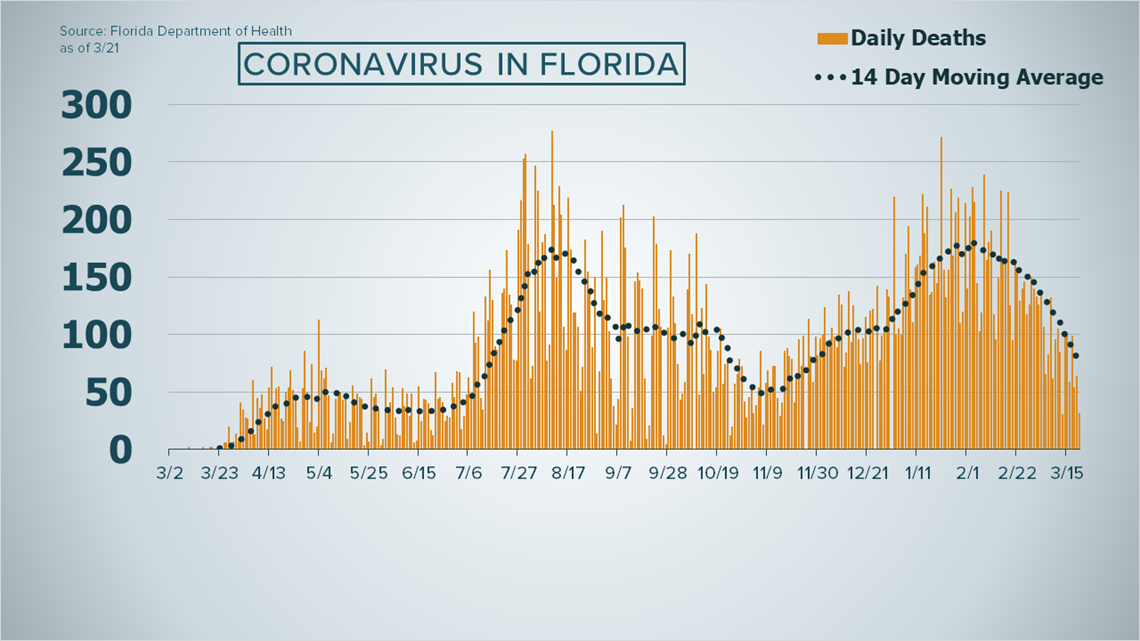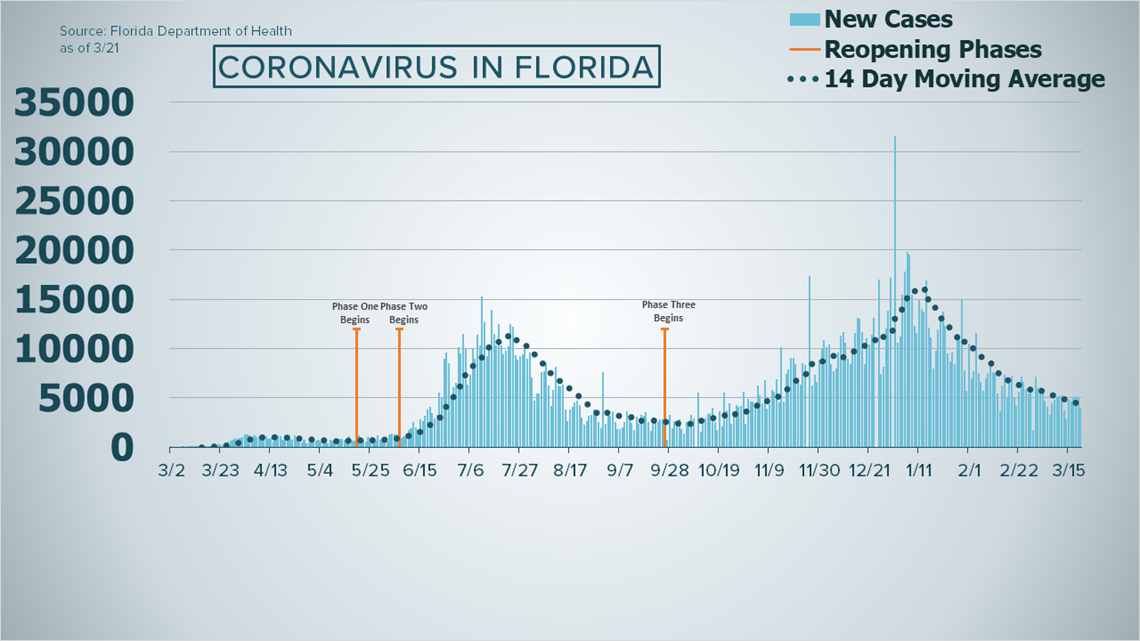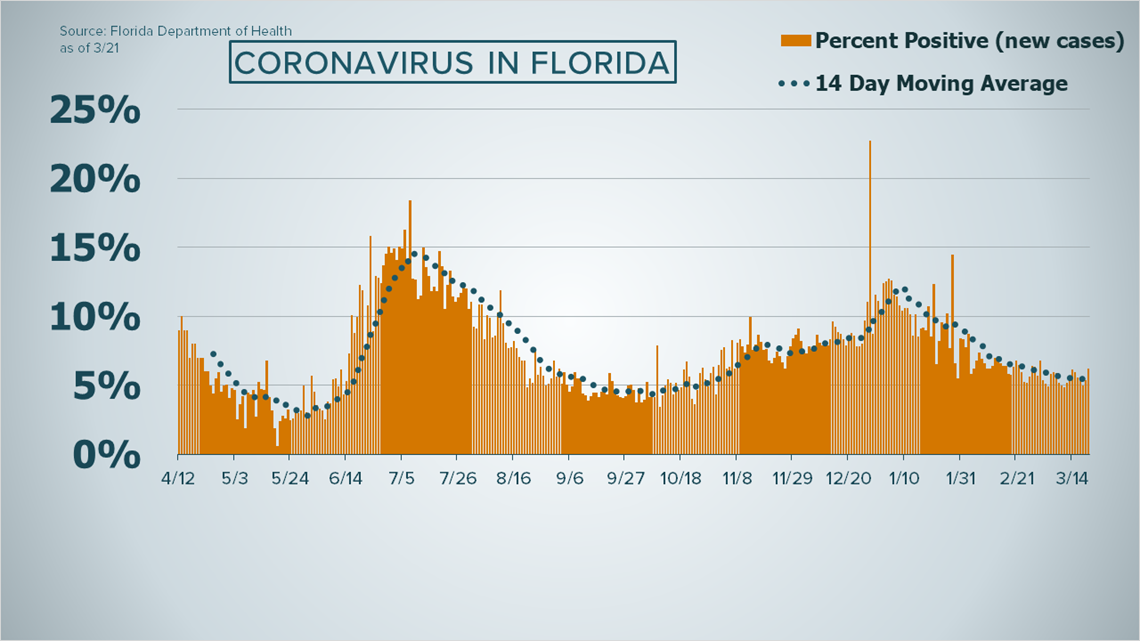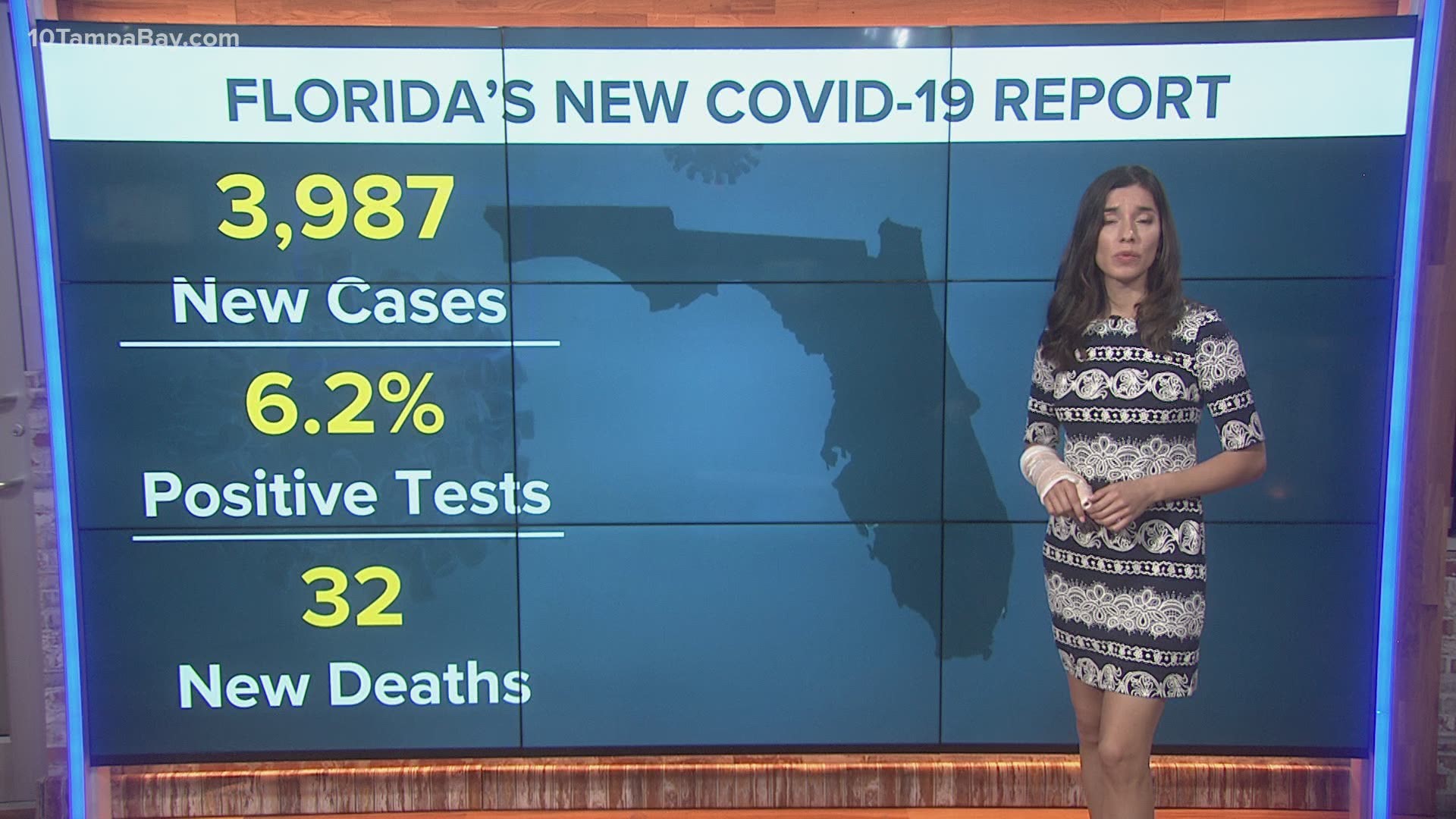TALLAHASSEE, Fla. — Florida added 3,987 coronavirus cases for March 20, according to the Florida Department of Health's latest report.
A total of 2,008,349 people in Florida have tested positive for the coronavirus since the pandemic began.
On Sunday, the state reported another 29 Floridians and three non-residents had died after testing positive for COVID-19. That brings the total to 32,742 residents and 627 non-residents who have died since the pandemic began – a total of 33,369 deaths in the state related to the virus.
Those numbers do not necessarily mean those people died Saturday, but rather the state learned of their deaths and added the number to the report that day. The state's line-by-line report, which you can read here, lists coronavirus deaths by the date the people tested positive for the virus, not the date they passed.


As for testing, the health department reported 6.23 percent of 76,260 test results returned from labs were positive for coronavirus through March 20.
The median age of Floridians testing positive is 37.
As for hospitalizations, 2,838 people in Florida were hospitalized with coronavirus as their primary diagnosis as of Sunday morning. Of those, 688 patients were in the Tampa Bay area.
Statewide, a total of 83,446 people in Florida were hospitalized with the virus at some point during the pandemic.
Here's a breakdown of new coronavirus cases reported to the state since February:
- February 1: 10,533
- February 2: 6,979
- February 3: 7,711
- February 4: 11,543
- February 5: 7,486
- February 6: 6,624
- February 7: 5,737
- February 8: 7,023
- February 9: 7,537
- February 10: 8,525
- February 11: 7,617
- February 12: 7,515
- February 13: 5,436
- February 14: 3,615
- February 15: 6,297
- February 16: 7,342
- February 17: 5,117
- February 18: 6,683
- February 19: 7,280
- February 20: 5,065
- February 21: 4,151
- February 22: 5,610
- February 23: 7,128
- February 24: 6,640
- February 25: 5,922
- February 26: 5,459
- February 27: 5,539
- February 28: 1,700
- March 1: 7,179
- March 2: 6,014
- March 3: 6,118
- March 4: 5,975
- March 5: 4,690
- March 6: 4,098
- March 7: 3,312
- March 8: 4,426
- March 9: 4,853
- March 10: 5,065
- March 11: 5,214
- March 12: 5,244
- March 13: 3,699
- March 14: 2,826
- March 15: 4,791
- March 16: 4,599
- March 17: 5,093
- March 18: 5,140
- March 19: 5,105
- March 20: 3,987


Understanding the numbers
Since mid-July, daily reported COVID-19 cases in Florida remained under 10,000. And, between Sept. 1 and Oct. 16, daily reported cases stayed below 4,000.
That changed on Nov. 15, when the state reported 10,105 new cases for the day prior.
The highest single-day case number Florida has reported so far is 19,816 for Jan. 6. The report released on Jan. 2 of 31,518 newly-reported cases is higher, but that report combined updates for Dec. 31 and Jan. 1.
The lowest single-day case number the state has reported since early June is 738, confirmed on Sept. 28.
On Oct. 30, Florida became the third state to cross the 800,000 reported COVID-19 cases mark. Then, on Dec. 1, Florida became the third state to surpass 1 million confirmed cases. On March 20, Florida became the third state to surpass 2 million confirmed cases. The United States has more than 29.7 million coronavirus cases as of March 21, the highest recorded number in the world, according to Johns Hopkins University of Medicine.
California and Texas have 3.6 and 2.7 million cases, respectively.
Florida's report released on Aug. 11 of 277 newly confirmed deaths was the highest seen from the state in a single day's report.
The state added a section to its daily report (on page 5) that shows deaths by date of death. This data has been reported daily on Florida's COVID-19 dashboard. The graph for deaths by date of death is subject to change, though, because the information reported to the state can be delayed up to two weeks. So, for consistency, our charts have stuck to new deaths added by the date they were added. For transparency, you can always reference the state's data here.
The positivity rate is crucial for reopening. The World Health Organization has repeatedly said it must remain at 5 percent or lower for a 14-day span for the agency to recommend reopening.
However, it can be somewhat misleading: The number of people tested statewide varies each day. Health officials say they would like to see a high – but steady – number of people tested every day and a suppressed percent positivity figure.
Florida has been in "Phase 3" of reopening since Sept. 25, when Gov. Ron DeSantis signed an order guaranteeing restaurants the right to operate and lifting state-level capacity restrictions on them.


Hospitalizations and ICU bed availability
New cases have been on the decrease in recent weeks, but what about hospitalizations?
Tracking hospitalizations got easier on July 10 when the Agency for Health Care Administration began publishing a spreadsheet with the number of people currently checked-in for coronavirus-related complications in Florida. The data only includes people whose "primary diagnosis" was COVID-19.
As of March 21, 2,838 people were hospitalized with COVID-19 as their primary diagnosis statewide, and 688 of them were in the Tampa Bay area. Those numbers are frequently updated, and you can click here for the most recent data, which is also broken down by county.
Since the pandemic began, the state confirms a total of 83,446 residents were hospitalized at some point during their illness.
The Agency for Healthcare Administration (AHCA) also updates total hospital bed and ICU availability by county.
Click here for a breakdown of adult and pediatric ICU bed availability by county. You can also check ICU availability by the hospital.
Hospitalizations around Tampa Bay and total staffed hospital bed capacity status:
**Data as of 11:30 a.m. on March 21
Citrus:
- 19 COVID-19 hospitalizations
- 106 of 300 total staffed hospital beds are available
DeSoto:
- 0 COVID-19 hospitalization
- 47 of 59 total staffed hospital beds are available
Hardee:
- 0 COVID-19 hospitalization
- 3 of 25 total staffed hospital beds are available
Hernando:
- 27 COVID-19 hospitalizations
- 212 of 625 total staffed hospital beds are available
Highlands:
- 27 COVID-19 hospitalizations
- 48 of 256 total staffed hospital beds are available
Hillsborough:
- 198 COVID-19 hospitalizations
- 981 of 4,201 total staffed hospital beds are available
Manatee:
- 35 COVID-19 hospitalizations
- 119 of 762 total staffed hospital beds are available
Pasco:
- 63 COVID-19 hospitalizations
- 279 of 1,430 total staffed hospital beds are available
Pinellas:
- 154 COVID-19 hospitalizations
- 908 of 3,194 total staffed hospital beds are available
Polk:
- 128 COVID-19 hospitalizations
- 424 of 1,714 total staffed hospital beds are available
Sarasota:
- 37 COVID-19 hospitalizations
- 191 of 1,292 total staffed hospital beds are available

